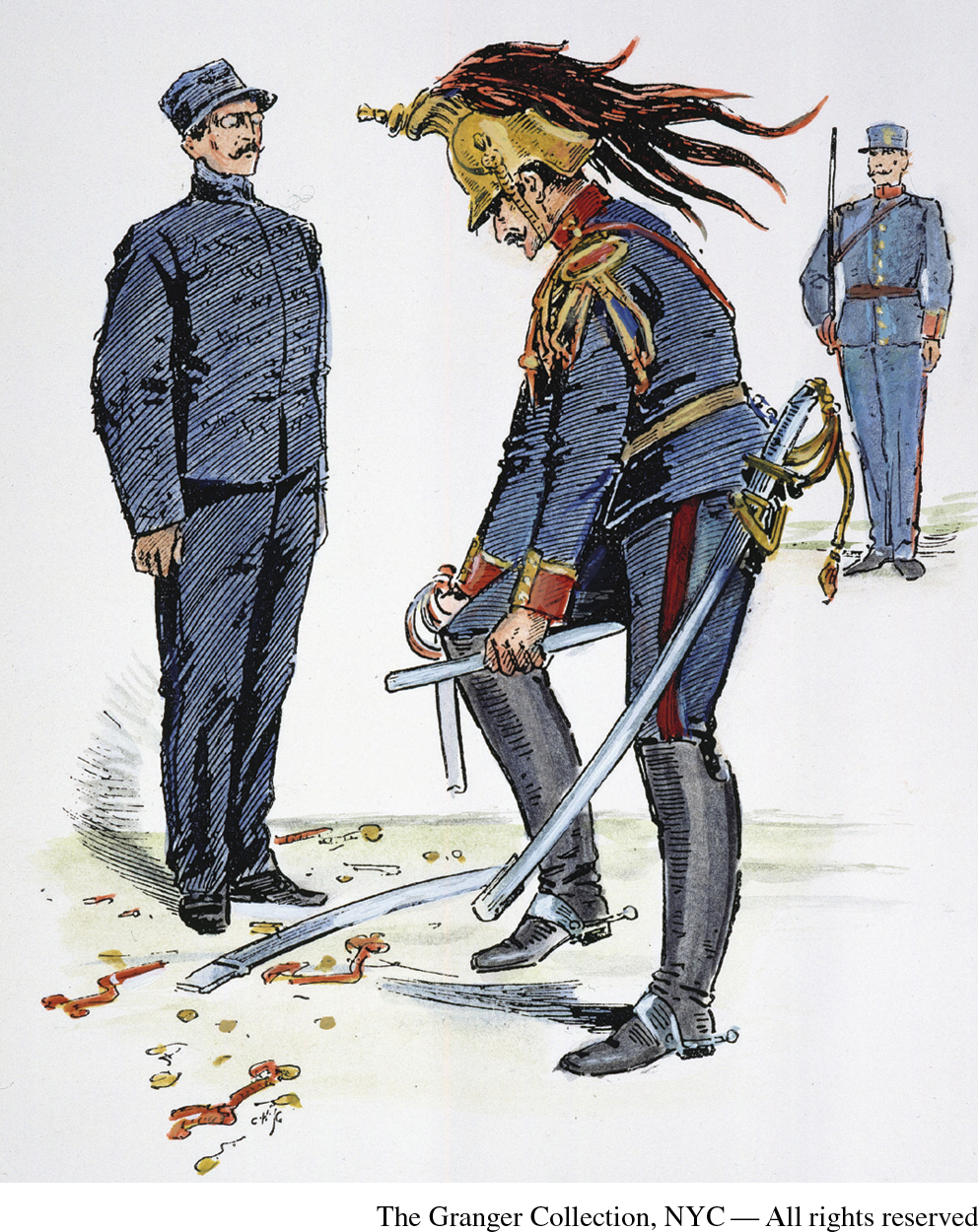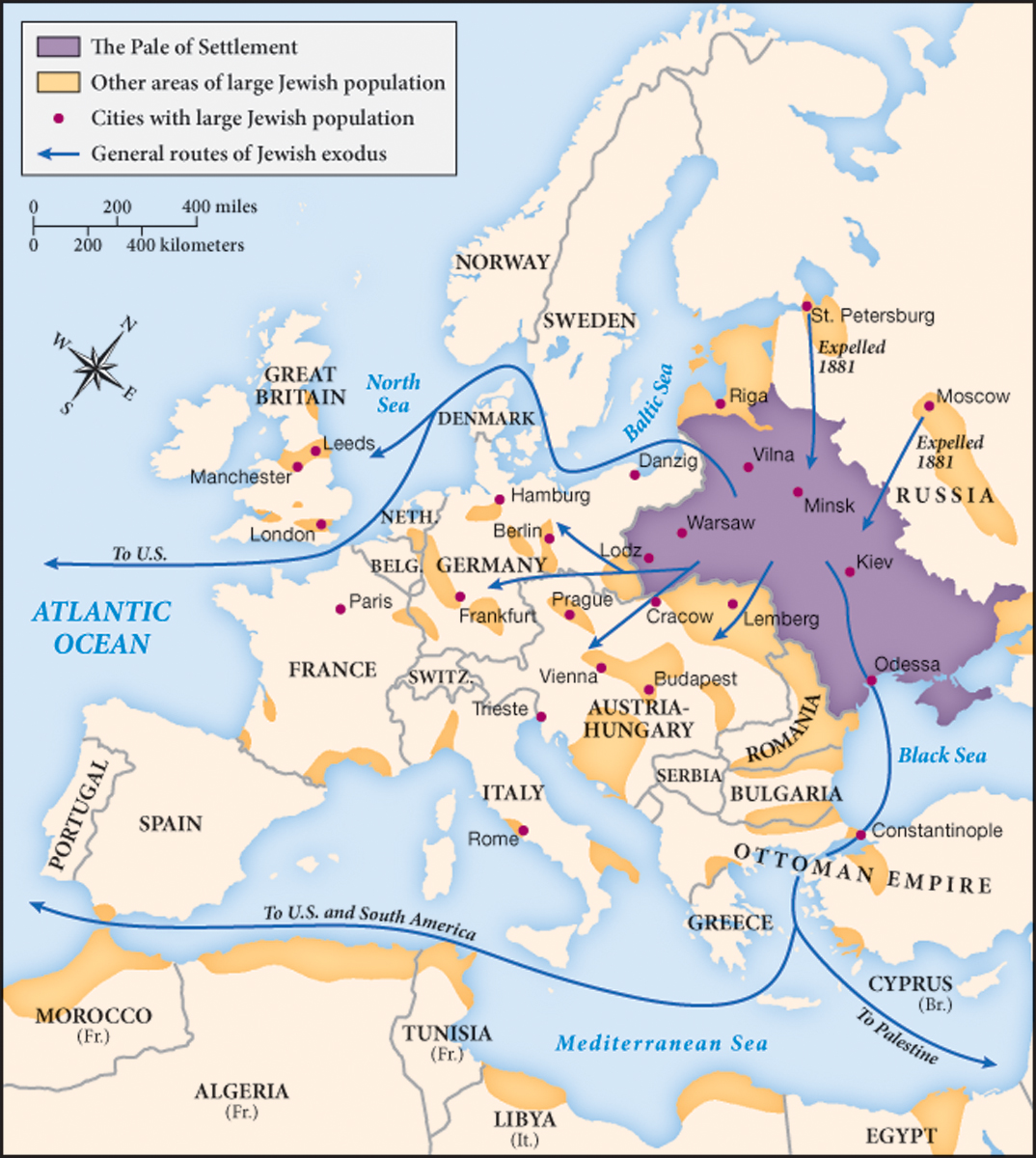Anti-Semitism, Nationalism, and Zionism in Mass Politics
Anti-Semitism, Nationalism, and Zionism in Mass Politics
The real crisis for liberal political values of equal citizenship and tolerance came in the two decades leading up to World War I when politicians used anti-Semitism and militant nationalism to win elections. They told voters that Jews were responsible for the difficulties of everyday life and that anti-Semitism and increased patriotism would fix all problems. Voters from many levels of society responded enthusiastically, agreeing that Jews were villains and the nation-state was the hero in the struggle to survive. In both republics and monarchies, anti-Semitism and militant nationalism provided those on the radical right with a platform to gain working-class votes and thus combat the radical left of social democracy. This new radical right included representatives of the agrarian nobility, aristocrats who controlled the military, and highly placed clergy, and it broke with liberal ideas of the rule of law and the equality of all citizens. Liberals had hoped that voting by the masses would make politics more harmonious as parliamentary debate and compromise smoothed out class and other differences. Instead politics became loud and hateful, a distinct departure from consensus building and rational debate.
A strong tradition of anti-Semitism already existed in Russian politics. Russian tsar Nicholas II (r. 1894–1917) believed firmly in Russian orthodox religion, autocratic politics, and anti-Semitic social values. Taught as a child to hate Jews, Nicholas blamed them for any failure in Russian policy. Pogroms became a regular threat to Russian Jews, as Nicholas increasingly limited where Jews could live and how they could earn a living.
Principles of equal citizenship and tolerance were also tested in France. Powerful forces in the aristocracy, the military, and the Catholic church hoped that the Third Republic, like earlier ones, could be overthrown. Economic downturns, widespread corruption, and attempted coups made the republic more vulnerable, and the press attributed failures of almost any kind to Jews. Despite an excellent system of primary education promoting literacy and rational thinking, the public tended to agree, while the clergy and monarchists kept hammering the message that the republic was nothing but a conspiracy of Jews.
Amid rising anti-Semitism, a Jewish captain in the French army, Alfred Dreyfus, was charged with spying for Germany in 1894. The military, whose upper echelons were traditionally aristocratic, Catholic, and monarchist, produced manufactured “evidence” to gain Dreyfus’s conviction even though the espionage continued. Then several newspapers received proof that the army had fabricated documents to convict Dreyfus. In 1898, the celebrated French novelist Émile Zola published an article titled “J’accuse” (I accuse) on the front page of a Paris daily, exposing the web of perjury that had created the impression of Dreyfus’s guilt.

The article, which named the truly guilty parties, led to public riots, quarrels among families and friends, and denunciations of the army. The government finally pardoned Dreyfus in 1899, dismissed the aristocratic and Catholic officers responsible for the false accusations, and ended religious teaching orders to ensure a secular public school system that honored toleration and the rule of law. Still, the Dreyfus Affair made anti-Semitism and official lies standard tools of politics by showing their effectiveness with the public.
The ruling elites in Germany also used anti-Semitism to win support from those who feared the consequences of Germany’s sudden and overwhelming industrialization. The agrarian elites, who still controlled the highest reaches of government, lost ground to industry as agriculture (from which they drew their fortunes) declined as a force in Germany’s economy. As industrialists grew wealthier and new opportunities drew rural workers to the cities, the agrarian elites came to loathe industry for challenging their traditional authority. A Berlin newspaper noted, “The agrarians’ hate for cities . . . blinds them to the simplest needs and the most natural demands of the urban population.” To woo the masses, conservatives and a growing radical right claimed that Jews, who made up less than 1 percent of the German population, were responsible for destroying traditional society. They hurled diatribes against Jews, new women, and Social Democrats, whom they branded as internationalist and unpatriotic. This new right invented a modern politics that rejected the liberal value of parliamentary consensus, relying instead on inventing enemies and thus dividing what was supposed to be a unified nation-state.
Politicians in the dual monarchy of Austria-Hungary also used militant nationalism and anti-Semitism to win votes, but here the presence of many ethnic groups meant greater complexity in the politics of hate. Foremost among the nationalists were the Hungarians, who wanted autonomy for themselves while forcibly imposing Hungarian language and culture on all other, supposedly inferior, ethnic groups in Hungary. Their nationalist claims rested on two pieces of evidence: Budapest was a thriving industrial city, and the export of Hungarian grain from the vast estates of the Magyar nobility saved the monarchy’s finances. The nationalists disrupted the Hungarian parliament so regularly that it weakened the orderly functioning of the government.
Although capable of causing trouble for the empire, Hungarian nationalists, who mostly represented agrarian wealth, were themselves vulnerable. Hungary’s exploited ethnic groups—Slovaks, Romanians, and Ruthenians—resisted Magyarization. Industrial workers struck to protest horrendous labor conditions, and 100,000 activists gathered in the fall of 1905 in front of the Hungarian parliament to demonstrate for the vote. Other nationalities across the Dual Monarchy intensified their demands for rights. Croats, Serbs, and other Slavic groups in the south called for equality with the Hungarians. The central government allowed the Czechs a greater number of Czech officials in the government because of the growing industrial prosperity of their region. But every step favoring the Czechs provoked outrage from the traditionally dominant ethnic Germans. When Austria-Hungary decreed in 1897 that government officials in the Czech region of the empire would have to speak Czech as well as German, the Germans rioted. Discriminatory policies toward these groups and scorn for the imperial government in Vienna created instability throughout Austria-Hungary.
Tensions mounted as German politicians in Vienna linked the growing power of Hungarians and Czechs to Jews. Karl Lueger’s newly formed Christian Social Party attracted members from among the aristocracy, Catholics, artisans, shopkeepers, and white-collar workers. Lueger appealed to those for whom modern life meant a loss of privilege and security. His hate-filled speeches helped elect him mayor of Vienna in 1895, but his ethnic nationalism and anti-Semitism threatened the multinationalism on which Austria-Hungary was based. Thereafter a widening group of politicians made anti-Semitism an integral part of their election campaigns, calling Jews the “sucking vampire” of modernity and blaming them for the tumult of migration, the economy, and just about anything else people found disturbing. Politics became a thing not of debate in parliaments but of violent racism in the streets.
Anti-Semites lumped Jewish people into one hated group, but like members of any other religion, Jews were divided by social class and education. Many Jews in western Europe moved out of Jewish neighborhoods, intermarried with Christians, and in some cases converted to Christianity—practices known as assimilation. Many well-educated Jews favored the classical culture of the German Empire because it seemed more rational and liberal than the ritualistic Catholicism of Austria-Hungary. By contrast, less prosperous Jews, such as those in Russia and Romania, were increasingly singled out for persecution, legally disadvantaged, and forced to live in ghettos. Jews from these countries might seek refuge in the nearby cities of central and eastern Europe where they could eke out a living as day laborers or artisans. Jewish migration to the United States and other countries also swelled (Map 24.1). By 1900, some Jews such as Freud were prominent in cultural and economic affairs in cities across the European continent even as far more were discriminated against and victimized elsewhere.

REVIEW QUESTION What were the points of tension in European political life at the beginning of the twentieth century?
Amid vast migration and continued persecution, a spirit of Jewish nationalism arose. “Why should we be any less worthy than any other . . . people?” one Jewish leader asked. “What about our nation, our language, our land?” In the 1880s, the Ukrainian physician Leon Pinsker, seeing the Jews’ lack of national territory as fundamental to their persecution, advocated the migration of Jews to found a homeland. (See “Document 24.1: Leon Pinsker Calls for a Jewish State.”) In 1896, Theodor Herzl, strongly influenced by Pinsker, called not simply for migration but for the creation of a Jewish nation-state, the goal of a movement known as Zionism. A Hungarian-born Jew, Herzl experienced anti-Semitism firsthand as a Viennese journalist and a writer in Paris during the Dreyfus Affair. Backed by eastern European Jews, he organized the first International Zionist Congress (1897). By 1914, some eighty-five thousand Jews had moved into Palestine—the region finally chosen for the Jewish nation.